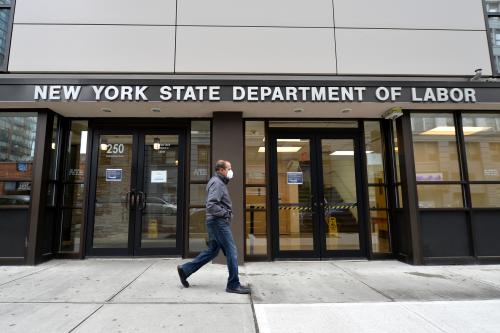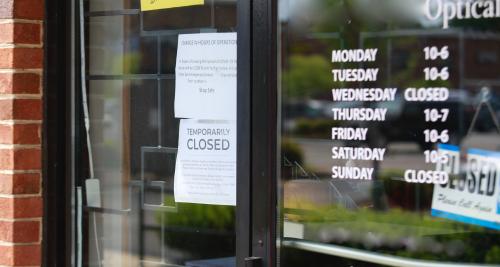Stephanie Aaronson, vice president and director of Economic Studies at the Brookings Institution, spent nearly two decades at the Federal Reserve Board, much of that time specializing in understanding the labor market. Here’s her take on the Bureau of Labor Statistics’ snapshot of the job market in June.
Q: Bottom line, what does this report tell us about the state of the economy?
The report clearly showed evidence of continued improvement related to the reopening of many parts of the economy following the shutdowns precipitated by the virus. The survey of employers showed payrolls were up by 4.8 million, and the job gains were in industries that were hardest hit by the pandemic, including leisure and hospitality and health services, which includes doctors’ and dentists’ offices. There is clear evidence that firms are hiring. The unemployment rate declined, for the second month, and the labor force participation rate – the share of adults working or looking for work – rose by seven-tenths of a percentage point. These are all consistent with the economy gradually reopening in the middle of June.
But we shouldn’t extrapolate from these trends because some states have scaled back their reopening because of the uptick in coronvavirus cases. It’s unclear what the state of the job market is right now or what we’ll see when the BLS releases its snapshot of the job market for mid-July.
Even in June, when people were pretty optimistic that we were recovering from the worst of the pandemic-induced recession, the economy was still suffering. Even though the unemployment rate has come down, unemployment is still close to where it was during the worst of the Great Recession. There are still 15 million fewer jobs in the U.S. in June than there were in February. The job market was improving in June, but it was still in very rough shape.
Q: What do we learn from the report about whether women and men are faring differently in this downturn?
One of the features of this recession is that the unemployment rate for women has gone up more than for men, but women have been no more likely to drop out of the labor market. There isn’t any sign – so far – that women are going to be dropping out of the labor market because they are responsible for more child care, contrary to some predictions.
Q: The unemployment rate soared in April, and fell in May and June. What do we learn from the unemployment rate and what does it obscure?
The movement in the unemployment rate obscures both the improvement and the extent to which things are still bad. In addition to the unemployment rate coming down, the labor force participation rate went up. The number of people working part-time who would prefer to work full-time came down. The number of people who say they are temporarily absent from work for “other reasons” – who should be counted as unemployed, but have been misclassified – has come down. The unemployment rate is just one measure of inactivity — of idle workers or slack in the labor market. When you put all those other numbers together, you get a much higher level of inactivity, but you still see improvement in June.
Q: Even though the unemployment rate has come down, we continue to see large numbers of people filing for unemployment insurance each week. How come?
The unemployment rate and initial claims for unemployment insurance are really measuring different things. UI claims are administrative data. People can file claims for many reasons. Some states don’t require you to be looking for work to get unemployment benefits, but to be counted as unemployed in the household survey, you need to be looking for work. There could be double counting in the UI claims. There could be fraud.
Remember also that there is a lot of churn in the job market – some people are getting hired while others are losing their jobs. Even though in the aggregate, the number of people who were unemployed went down, close to 4 million people lost their jobs in June and 6 million people filed initial claims between the middle of May and the middle of June.
Q: What does it mean when the BLS says someone is “out of the labor force” and what does that measure tell us now?
The BLS counts a person in the labor force if he or she is working or actively looking for work. The share of adults who are doing so is called the labor force participation rate. The labor force participation rate is typically not very cyclical; it doesn’t move as much up or down as the unemployment rate does. This time is different. The labor force participation rate fell much more than we would have expected in March and April and it has bounced back very rapidly, though it still remains low. Because of the unusual nature of this shock, people have been moving in and out of the labor force much more than you’d expect in a typical recession. So, it’s too soon to tell whether the movement of people out of the labor market during the pandemic is going to be a long-term structural problem, but the fact that the labor force participation rate has bounced back is encouraging.
Q: What does this report tell us about people who are on “temporary layoff” and likely to be called back to work versus those whose jobs are gone forever?
It’s very hard to tell. There was a big decline in the number of people on temporary layoff – from about 15 million to about 10.5 million – but we don’t actually know whether the decline reflects people who went back to work or those who moved out of “temporary layoff” status to something more permanent. One encouraging sign: The number of people who have been unemployed for less than five weeks – the newly unemployed, you might call them – has fallen.







Commentary
What does the June jobs report tell us about the state of the U.S. economy?
July 2, 2020